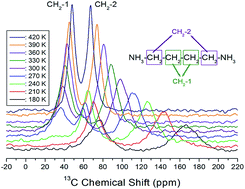Thermal property and structural molecular dynamics of organic–inorganic hybrid perovskite 1,4-butanediammonium tetrachlorocuprate †
Abstract
We investigate the thermal behaviour and physical properties of the crystals of the organic inorganic hybrid perovskite [(NH3)(CH2)4(NH3)]CuCl4. The compound's thermal stability curve as per thermogravimetric analysis exhibits a stable state up to ∼495 K, while the weight loss observed near 538 K corresponds to partial thermal decomposition. The 1H nuclear magnetic resonance (NMR) chemical shifts for NH3 change more significantly with temperature than those for CH2, because the organic cation motion is enhanced at both ends of the organic chain. The 13C NMR chemical shifts for the ‘CH2-1’ units of the chain show an anomalous change, and those for ‘CH2-2’ (units closer to NH3) are shifted sharply. Additionally, the 14N NMR spectra reflect the changes of local symmetry near TC (=323 K). Moreover, the 13C T1ρ values for CH2-2 are smaller than those for CH2-1, and the 13C T1ρ data curve for CH2-1 exhibits an anomalous behaviour between 260 and 310 K. These smaller T1ρ values at lower temperatures indicate that 1H and 13C in the organic chains are more flexible at these temperatures. The NH3 group is attached to both ends of the organic chain, and NH3 forms a N–H⋯Cl hydrogen bond with the Cl ion of inorganic CuCl4. When H and C are located close to the paramagnetic Cu2+ ion, the T1ρ value is smaller than when these are located far from the paramagnetic ion.



 Please wait while we load your content...
Please wait while we load your content...